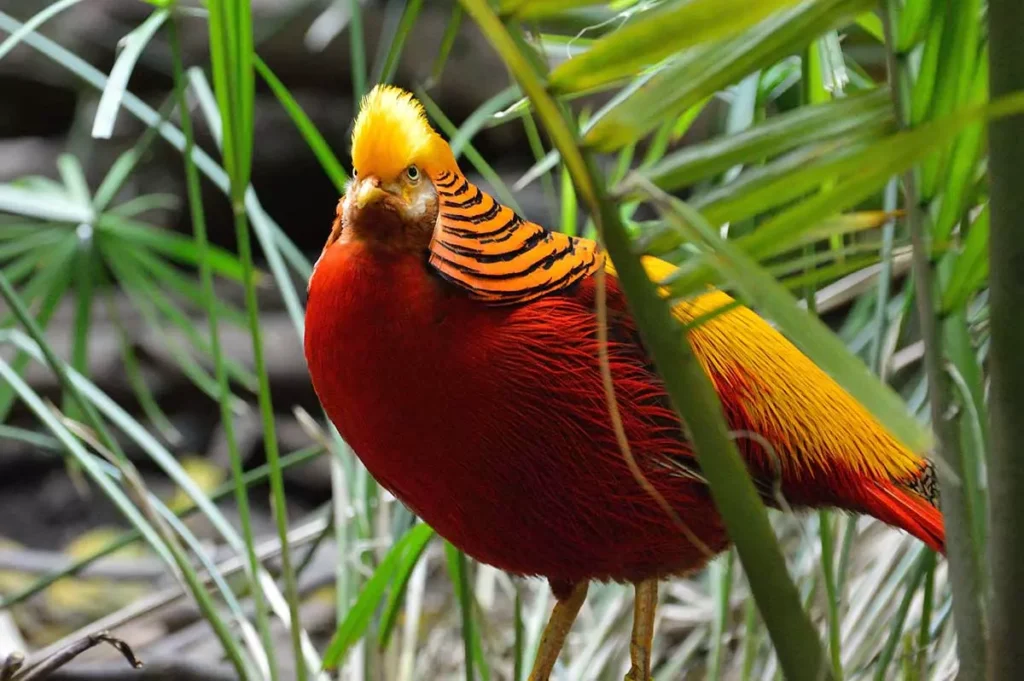
Golden pheasant (Chrysolophus pictus), also known as Chinese pheasants, rainbow pheasants, and red golden pheasants, are among the most fascinating animals in the bird world. Known for their vibrant and colorful plumage, these gallinaceous birds are native to the dense forests of western China. In this article, we will explore the captivating world of golden pheasants, delving into their origins, habitat, appearance, behavior, and more.
Origins and Habitat of Golden pheasant
Golden pheasants are native to the dense forests and mountainous areas of central and western China. In their natural habitat, these birds prefer areas with sparse undergrowth, where they can easily forage close to the ground. Although they are sometimes found near human settlements, they generally shy away from heavily populated areas.
These birds thrive in dense forests and mountainous areas, where they can roost in trees at night and seek cover during the day. Their preferred habitat offers them protection from predators and ample food sources such as seeds, insects, and berries.

Striking Appearance of Golden pheasant
Adult Male Golden pheasant
The adult male golden pheasant boasts a striking appearance, with a bright red body, red golden highlights, and a deep orange “cape” that can be spread in display. The golden crest on their heads, paired with blackish brown accents, gives these birds their common name. Their bright yellow eye, complemented by a pinpoint black pupil, is encircled by a patch of bare, blue orbital skin. The male’s tail is long and barred with alternating black and cinnamon bands, while their upper back displays a wild type pattern. This impressive male plumage, along with their yellow bills, helps them attract a mate during the breeding season.
Female Golden Pheasant
Female golden pheasants are more modest in appearance, with mottled brown, plain buff, and barred buff feathers that help them blend into their surroundings. This camouflaging plumage, along with their yellow legs and buff face, is essential for protecting them and their eggs from predators. Despite their less vibrant appearance, female golden pheasants remain one of the more fascinating animals among bird species. Interestingly, there are instances of abnormal females exhibiting brighter colors, making them stand out in the wild.

Golden pheasant mating and breeding season
The Courtship Display
During the breeding season, male golden pheasant engages in an elaborate courtship display to attract a mate. It will spread their orange fan, raise their golden crest, and display their vibrant plumage. The male’s showy appearance and distinctive wing sound serve to entice the more subdued females.
Nesting and Egg-Laying
Once a female golden pheasant is sufficiently impressed by a male’s display, she will select a suitable nesting site on the ground, usually hidden among dense vegetation. She will then lay a clutch of 8 to 12 eggs, which she incubates for about 22 to 23 days. The chicks, once hatched, are able to follow their mother and forage for food almost immediately.
Golden pheasant behavior and communication
Wing Sound
Golden pheasants communicate with each other using a variety of vocalizations, including a metallic call that can be heard over long distances. In addition to their vocalizations, they produce a distinctive wing sound when they are startled and suddenly burst upwards. This sound serves as an alarm signal to other pheasants nearby, alerting them to potential danger.
Flight and Foraging of Golden pheasant
Golden pheasant is a strong runner and can fly clumsily in short bursts when necessary. However, it prefers to stay on the ground, where it forages for food and can quickly take cover if threatened. It is also known to be excellent swimmers, able to escape predators by diving into water.
Golden pheasant Diet and Feeding Habits
Golden pheasants are omnivorous, with a diet consisting primarily of seeds, leaves, and insects. They are particularly fond of eating berries, and during the winter months, they have been observed taking primarily wheat leaves from cultivated fields. These birds spend most of their day foraging on the ground, using their strong beaks to dig for grubs and other small invertebrates.

Predators and Survival Strategies
Golden pheasant faces numerous predators, including birds of prey, foxes, and wildcats. To avoid predation, they rely on their cryptic plumage and their ability to blend into their surroundings. If threatened, they will often freeze in place, relying on their camouflage to keep them hidden from predators. When startled, they can take off in a sudden burst of speed, flying just above the ground to escape danger.
Conservation Status of Golden pheasant
Currently, golden pheasant is not considered to be at risk of extinction. However, their populations in the wild have been impacted by habitat loss and hunting. In response to these threats, conservation efforts have been put in place to protect their natural habitat and regulate hunting.
Golden Pheasants in Captivity
Golden pheasant has become popular in aviculture due to its stunning appearance and hardy nature. It adapts well to captivity and can be found in zoos, aviaries, and private collections around the world. Captive breeding programs have resulted in a variety of different mutations, including the “yellow golden,” “dark-throated golden,” and “silver golden.”

Conclusion
Golden pheasants are truly remarkable birds, with their vibrant red golden plumage and fascinating behaviors, such as their ability to eat berries at great speed, capturing the attention of bird enthusiasts and casual observers alike. With a total length of around two thirds of a meter, these captivating creatures, known by the genus name Chrysolophus pictus, are distinct from other types of pheasants. As we continue to learn more about them, including unique features like the intricate pattern on the female’s breast, it is crucial that we work to conserve their natural habitats and ensure their survival in the wild for generations to come.
